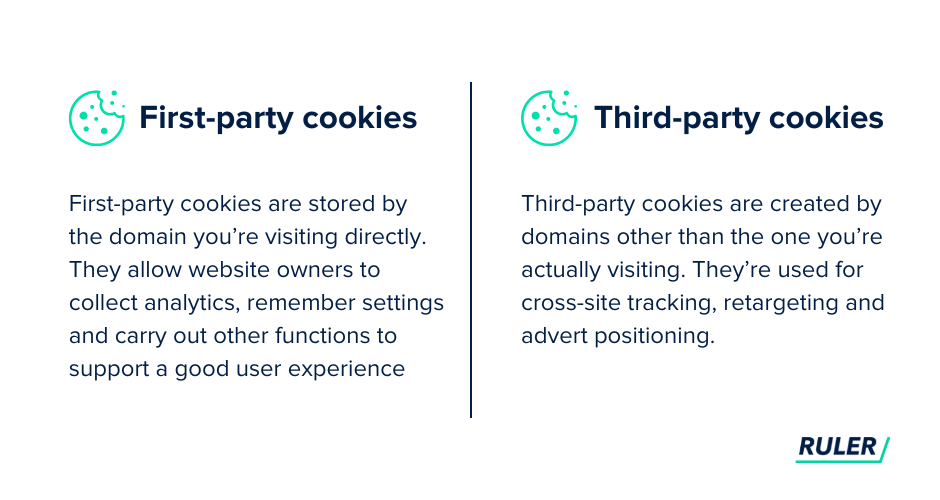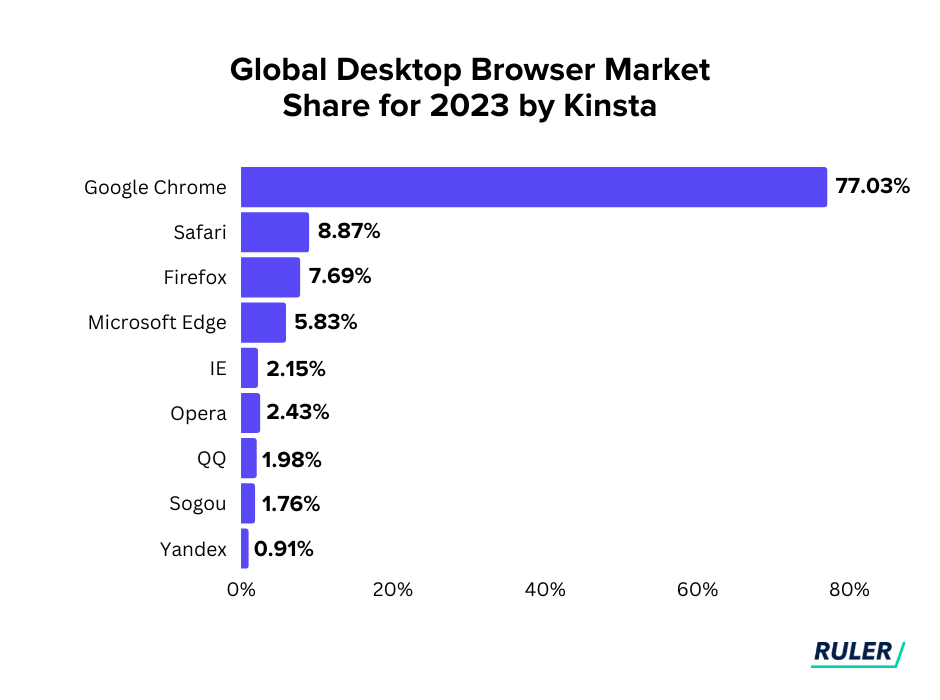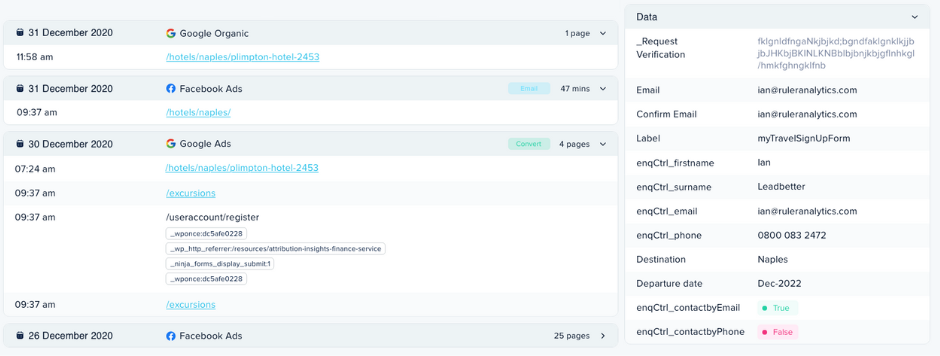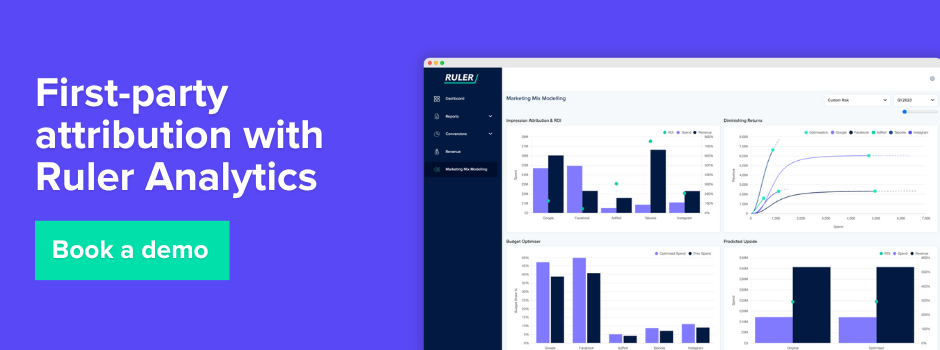Wondering about the future of third-party cookies? With Google announcing changes we explore how marketers can best plan for the decline of third-party cookies.
Third-party cookies have been a cornerstone of advertising for years, but this era is rapidly drawing to a close.
Safari and Firefox have already ditched third-party cookies to boost user privacy.
And while Google has pumped the brakes on fully getting rid of them in Chrome, they’re still giving users the option to opt-out.
For advertisers, this means a major shift.
The days of tracking users across the web and delivering personalised ads through third-party cookies are numbered.
So, what’s an advertiser to do? Let’s find out, as we discuss:
💡 Pro Tip
The launch of Apple’s ATT and the limitations around cookies has made traditional multi-touch attribution less effective. We’re on a journey to combine multi-touch attribution and marketing mix modelling (MMM) to create a more effective approach to marketing measurement. Book a demo to learn more.
A third-party cookie is a cookie that is set by a domain that is different from the domain of the website you are currently visiting. They are often used for online advertising purposes and allow marketers to track users’ browsing behaviour across multiple websites.
Let’s say you visit a website to read a news article.
That website might use first-party cookies (we’ll get to these shortly) to remember your preferences or to track your activity on their website.
It may also contain third-party cookies from advertisers or analytics tools that are embedded on the page.
These third-party cookies can then track your activity across other websites that also use the same advertiser or analytics tool.
Some common examples of third-party cookies include:
Third-party cookies aren’t the only way to get user data and target the right people. There are also first-party cookies.

First-party cookies are created by the website that the user is visiting, and are used to remember user preferences and to improve the user experience on the site.
From a technical perspective, there’s not any major difference between the two types of tracking cookies.
Both cookies contain the same pieces of information and can perform similar functions. The real difference between these two cookie types is how they’re created and used. We break it down in the table below.
| Cookie type | First-party cookies | third-party cookies |
| Created by | The website you’re visiting | Websites other than the one you’re visiting |
| Accessible to | Only the website that created it | Any website that loads the third-party server’s code |
| Used for | Remembering user preferences, login information, and other settings; improving the user experience | Tracking users across the web for targeted advertising and other purposes |
| Example | A shopping cart cookie, a language preference cookie, a login cookie | A social media tracking cookie, an advertising cookie, an analytics cookie |
| Browser support | Supported by all browsers | Blocked by Safari and Firefox web browsers. Google to block third-party cookies in 2024. |
Third-party cookies have become increasingly controversial in recent years due to privacy concerns.
While they have been useful for advertisers, they have also been a source of frustration.
Many users find the idea of being tracked across the web to be intrusive, driving an increasing demand for more control over personal data.
In response to these concerns, major web browsers such as Firefox and Safari implemented restrictions on third-party cookies in 2013.
Fast forward to 2020, and Google dropped the bombshell that it would also be phasing out support for third-party cookies.
The industry braced itself for a world without third-party cookies, filled with debates over what would replace them and whether marketers were ready for the shift.
But then, in a surprising twist in 2024, Google announced a change of plans.
Instead, Google will now give users the power to opt out of third-party cookies if they choose.
Google’s move to let users opt-out of third-party cookies will significantly is expected to disrupt digital advertising. In 2023, Google Chrome, Safari and Firefox made up 94% of the global desktop browser market share.

Once Google allows users pull the plug on third-party cookies, marketers will be faced with a number of challenges, including:
The decline of 3P cookies has forced marketers to rethink their approach towards online tracking and advertising.
While it may pose some challenges, it also presents an opportunity for marketers to invest in new technologies and strategies to prioritise user privacy and still allow for effective targeting and personalisation.
Here are four ways advertisers are fighting against the fall of third-party cookies.
First-party data is the top priority for most marketers.
Remember, Google isn’t phasing out all cookies. It’s third-party cookies we’re waving goodbye to, not first-party cookies.
With first-party data, businesses can navigate the phase-out of third-party cookies by enabling them to establish a more direct and personal relationship with their customers, comply with privacy regulations, and gain greater control over the quality and accuracy of the data they collect.
There a few ways to collect first-party data:
Another way to collect first-party data is to use a tracking tool like Ruler Analytics.
It tracks website visitor touchpoints and connects them to revenue data, providing insight into which marketing channels and campaigns are generating the most profitable outcomes.

Ruler allows you to create your own first-party cookies directly on your own domain, so you can keep tabs on users throughout their visits and interactions.
It helps you track where your leads come from and link closed sales back to your marketing efforts.
We have a guide on how Ruler tracks full customer journeys, which tells you everything you need to know.
Contextual targeting is one approach that marketers are using to address the decline of third-party cookies.
With third-party cookies being phased out, contextual targeting offers an alternative way for advertisers to reach their target audience.
By analysing the content of a web page or app, advertisers can determine the topics or themes that are most relevant to their target audience and serve ads accordingly.
For example, let’s say you’re browsing a website about gardening and reading an article about how to plant tomatoes.
The website uses contextual advertising to display ads that are relevant to the content on the page. In this case, you might see ads for gardening tools, tomato seeds, or other gardening-related products.
The website uses technology to scan the text on the page and identify keywords that are relevant to the content. The advertising platform then uses these keywords to display ads that are likely to be of interest to the user.
Contextual targeting has many benefits over third-party cookie-based targeting. Some of these include:
Next up we have people-based targeting.
With the ongoing shift away from third-party cookies, people-based targeting is becoming increasingly important for advertisers.
People-based targeting is a type of ad targeting that relies on first-party data, such as data collected from a company’s own website or mobile app, to identify and target specific individuals with ads.
People-based targeting typically involves the following steps:
Traditional marketing measurement methods, such as those that rely on cookies in general, are becoming less reliable.
This isn’t just a problem with third-party cookies; even first-party cookies are facing challenges.
While they’re crucial to your measurement strategy, Apple’s ITP significantly reduces the lifespan of first-party cookies in Safari, limiting them to 1-7 days depending on settings.
Also, regulatory frameworks like GDPR and CCPA are increasing the risks associated with cookie usage.
Further complicating matters, people use a variety of channels to make purchases, from different devices to viewing ads and then visiting the site directly.
Cookies struggle to track this, leading to fragmented journeys and a high percentage of conversions in analytics attributed to the last click source, often direct search or brand.
To overcome these challenges, adopting multiple measurement methods is essential. This helps you understand the big picture of your marketing efforts, even with limited data.
Take attribution and MMM, for example.
Tracking prior touchpoints through multi-touch attribution allows you to see the trackable touchpoints leading up to a conversion. This lays the groundwork for accurate data tracking.
When identifiers like cookies or IDs aren’t available due to browser limitations, iOS restrictions, or ad blockers, MMM acts as a data-driven compass, measuring the incremental impact of your marketing.
Through statistical modelling, MMM can examine cross-channel influences, helping marketers better understand the modern customer journey. This includes recognising the impact of an online campaign on direct/brand searches.

Image source: Ruler Analytics MMM dashboard
Attribution and MMM are just two examples.
By combining multiple measurement approaches, marketers can gain a more comprehensive understanding of their campaigns’ effectiveness and optimise their strategies in a world increasingly reliant on privacy-focused technologies.
Third-party cookies are becoming less reliable, but it isn’t necessarily a bad thing.
This shift in data collection has allowed us to rethink how we collect and use data in a more privacy-conscious and user-friendly way.
And by leveraging first-party data and people-based targeting strategies, advertisers can deliver more personalised and relevant ad experiences.
Don’t forget. Ruler simplifies first-party data collection and uses attribution and MMM to accurately measure the performance of your channels and campaigns.
You can see how Ruler Analytics works by booking a demo with our team. We’ll show you how Ruler uses first party data to track your website users and closes the gap between your marketing and revenue.
